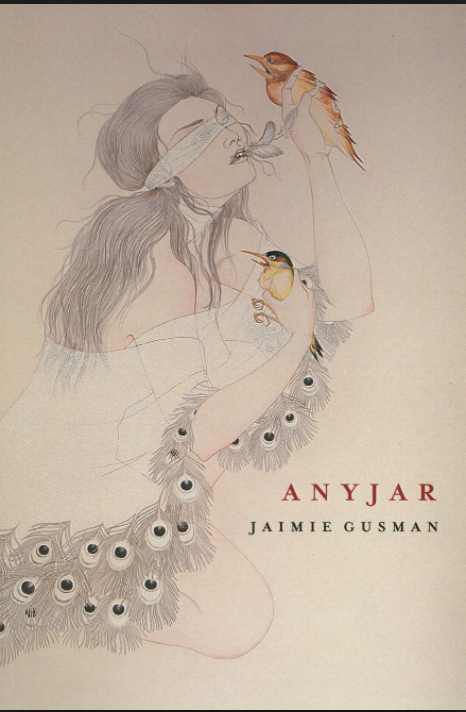ISSN: 1941-4137
POETRY THAT ENACTS THE ARTISTIC AND CREATIVE PURITY OF GLASS
POETRY THAT ENACTS THE ARTISTIC AND CREATIVE PURITY OF GLASS

Samuel Binns lives in Fayetteville, Arkansas, where he studies poetry at University of Arkansas. When he grows up, he wants to be a tree.
August 8, 2018
Edited by Stephanie Kaylor
Edited by Stephanie Kaylor
A Vessel of Change: Review of Anyjar by Jaimie Gusman
 Anyjar
by Jaimie Gusman
Black Radish 2017
Jaimie Gusman’s first book of poems, Anyjar (Black Radish 2017), presents itself as a trickster poetics. The poems shape-shift, subvert boundaries, and epitomize the bewilderment of reality by playing with paradox and space. Anyjar is a protest of borders and embraces ambiguity and the eternal.
One of the epigraphs that Gusman uses to ground the wiliness of the Anyjar is from Susan Howe’s Singularities:
All things double on one another
on to pure purpose.
Expanding upon this elliptical theme, the Anyjar is best represented not as a manufactured object, but instead the spirit or energy of a spiral, a representation of the eternal flux of life as it unfolds. Therefore, the Anyjar, a playful Being of Gusman’s imagination, resides in a liminal space, a space of thresholds, a place of unknowing. The Anyjar is unmeasurable and indefinable because it is always changing. The Anyjar is a mother (“The Anyjar breastfed the hell out of me”), “is not anything at all,” “is not the other half.” The Anyjar is the whole, a gestalt.
The Anyjar, a “systemic approach to the epistemological discovery of collective remembrance,” slouches toward Plato's concept of anamnesis. In other words, Anyjar is attempting to playfully provoke the reader to remember eternal truths by asking questions, guiding reasoning, and revealing the innate abilities of the human mind by “(unfolding our story / then folding it / then storing the folds)” as a spiral does. As Gusman later affirms, “Memory is not practical but memory is practice.” Memory, like the Anyjar, is a trickster that runs from us as we attempt to chase it.
Through the character of the Anyjar, Gusman frames the labyrinthine passages that we must navigate throughout life. With each labyrinth, there is an escape, and the theme of escape runs rampant throughout several different poems:
“In the dream I am escaping / the narrative of invisible glass”
“I try exiting, I keep knocking down / the exit, but the knocks are mute”
“The name of the red-head bird escapes us”
“I try to figure out / here was the Anyjar / in my own voice / and it escaped”
“But I accuse him of planning the escape.”
“In the evening I walk out the door / like every possibility is a circle beyond”
“Wake up and evacuate to the sky.”
The figure of the Anyjar and the poems as a whole are always on the move, providing a ball of thread to navigate and follow to find a way through the labyrinth of life, memory, the body. Gusman further displays this movement by dividing Anyjar into three sections: Incredible Conception, The Habitual Fleet of Imagination, and Funeral Poems. However, the Anyjar has no beginning nor end. Gusman affirms the eternal energy of Anyjar by writing
No hello-ing/goodnight-ing
this is where we live,
between perpetually and extinctly.
Anyjar roams and floats back and forth in the infinite space of betweenness: bridges, staircases, shores. Although two of the sections (Incredible Conception and Funeral Poems) imply a birth and a death, the Anyjar is invincible. In one poem, Gusman reveals that the Anyjar is composed out of glass, but it is unbreakable:
I found a chain-saw, revved the engine like a quake of earth and sawed the hell out of the Anyjar, but what happened next was disappointing because nothing shattered except my right knuckles all bloody
In this poem, “And like MAGIC Anyjar is Gone,” Gusman reveals the playful and teacherly qualities of the Anyjar figure as it evades authoritative structures in order to preserve its creative and imaginative force. The Anyjar subverts our desire for power and authority over things. The Anyjar challenges our values, and as we participate in the episodes, we must recognize the aspects of ourselves that relate to Anyjar's changing nature. The Anyjar is able to escape the structures fabricated by humans, which allows us to see our own social structures in a new light. The Anyjar provokes us to break down borders and change the things that need to be changed without limitation:
“Anyjar exchange — I am amusing / a design that builds as it breaks.”
Gusma¬n’s Anyjar also deals with attachment, loss, and emptiness. Although jars as objects are meant to hold and carry, we wonder if the jar is empty or full. The poem “Phantom” proposes this question:
What if Anyjar doesn’t
hold any life?
If I manage to open it
will every secret spread and change?
The poem “Explode, Expunge, but Hold on Tight” further expresses the concept of holding and possession. The line “Anyjar a spill, ship a swell” indicates that Anyjar is a vessel. Gusman also reveals that “our extensions
are supposed to remain outside of the jar. / But we both grab at the emptiness, never enough for two
”
Several of these excerpts revolve around the theme of emptiness, attachment, and detachment.
In the poem “Omit the Anyjar,” Gusman writes:
But I feel unattached
I cannot say hold on,
Or anything.
These excerpts echo the Buddhist concept of sunyata, which is a Sanskrit word that translates to “emptiness” in English. Sunyata or emptiness does not mean that there is an absence of matter, but instead emptiness teaches the lack of substantiality or independence of things, meaning that a previous state caused the present state of all things. Emptiness includes the teaching of impermanence because everything is always in a state of flux. The Anyjar is a process of becoming. Anyjar is a verb. Gusman plays upon the idea of space to describe the landscape as alive with transformation: “I see in your eyes levels of / Anyjar / flood / changing the geometry of the landscape.”
The poems within Anyjar exist in a continual state of evolution and movement.
Anyjar, like a child, bears the gift of playfulness, a gift that invokes insight and understanding. Anyjar's own transformations provoke us to continuously maintain malleability and transform ourselves:
Anyjar is filled with change,
We are mobile as well.
The constant do something,
The jar demands so much already.
The Anyjar is beyond measurement, beyond boundary, beyond shape. “The Anyjar will remove your skin”
“the Anyjar will make you a new thing.” Anyjar is a vessel of change.
Visit Jaimie Gusman's Website
Visit Black Radish' Website
Anyjar
by Jaimie Gusman
Black Radish 2017
Jaimie Gusman’s first book of poems, Anyjar (Black Radish 2017), presents itself as a trickster poetics. The poems shape-shift, subvert boundaries, and epitomize the bewilderment of reality by playing with paradox and space. Anyjar is a protest of borders and embraces ambiguity and the eternal.
One of the epigraphs that Gusman uses to ground the wiliness of the Anyjar is from Susan Howe’s Singularities:
All things double on one another
on to pure purpose.
Expanding upon this elliptical theme, the Anyjar is best represented not as a manufactured object, but instead the spirit or energy of a spiral, a representation of the eternal flux of life as it unfolds. Therefore, the Anyjar, a playful Being of Gusman’s imagination, resides in a liminal space, a space of thresholds, a place of unknowing. The Anyjar is unmeasurable and indefinable because it is always changing. The Anyjar is a mother (“The Anyjar breastfed the hell out of me”), “is not anything at all,” “is not the other half.” The Anyjar is the whole, a gestalt.
The Anyjar, a “systemic approach to the epistemological discovery of collective remembrance,” slouches toward Plato's concept of anamnesis. In other words, Anyjar is attempting to playfully provoke the reader to remember eternal truths by asking questions, guiding reasoning, and revealing the innate abilities of the human mind by “(unfolding our story / then folding it / then storing the folds)” as a spiral does. As Gusman later affirms, “Memory is not practical but memory is practice.” Memory, like the Anyjar, is a trickster that runs from us as we attempt to chase it.
Through the character of the Anyjar, Gusman frames the labyrinthine passages that we must navigate throughout life. With each labyrinth, there is an escape, and the theme of escape runs rampant throughout several different poems:
“In the dream I am escaping / the narrative of invisible glass”
“I try exiting, I keep knocking down / the exit, but the knocks are mute”
“The name of the red-head bird escapes us”
“I try to figure out / here was the Anyjar / in my own voice / and it escaped”
“But I accuse him of planning the escape.”
“In the evening I walk out the door / like every possibility is a circle beyond”
“Wake up and evacuate to the sky.”
The figure of the Anyjar and the poems as a whole are always on the move, providing a ball of thread to navigate and follow to find a way through the labyrinth of life, memory, the body. Gusman further displays this movement by dividing Anyjar into three sections: Incredible Conception, The Habitual Fleet of Imagination, and Funeral Poems. However, the Anyjar has no beginning nor end. Gusman affirms the eternal energy of Anyjar by writing
No hello-ing/goodnight-ing
this is where we live,
between perpetually and extinctly.
Anyjar roams and floats back and forth in the infinite space of betweenness: bridges, staircases, shores. Although two of the sections (Incredible Conception and Funeral Poems) imply a birth and a death, the Anyjar is invincible. In one poem, Gusman reveals that the Anyjar is composed out of glass, but it is unbreakable:
I found a chain-saw, revved the engine like a quake of earth and sawed the hell out of the Anyjar, but what happened next was disappointing because nothing shattered except my right knuckles all bloody
In this poem, “And like MAGIC Anyjar is Gone,” Gusman reveals the playful and teacherly qualities of the Anyjar figure as it evades authoritative structures in order to preserve its creative and imaginative force. The Anyjar subverts our desire for power and authority over things. The Anyjar challenges our values, and as we participate in the episodes, we must recognize the aspects of ourselves that relate to Anyjar's changing nature. The Anyjar is able to escape the structures fabricated by humans, which allows us to see our own social structures in a new light. The Anyjar provokes us to break down borders and change the things that need to be changed without limitation:
“Anyjar exchange — I am amusing / a design that builds as it breaks.”
Gusma¬n’s Anyjar also deals with attachment, loss, and emptiness. Although jars as objects are meant to hold and carry, we wonder if the jar is empty or full. The poem “Phantom” proposes this question:
What if Anyjar doesn’t
hold any life?
If I manage to open it
will every secret spread and change?
The poem “Explode, Expunge, but Hold on Tight” further expresses the concept of holding and possession. The line “Anyjar a spill, ship a swell” indicates that Anyjar is a vessel. Gusman also reveals that “our extensions
are supposed to remain outside of the jar. / But we both grab at the emptiness, never enough for two
”
Several of these excerpts revolve around the theme of emptiness, attachment, and detachment.
In the poem “Omit the Anyjar,” Gusman writes:
But I feel unattached
I cannot say hold on,
Or anything.
These excerpts echo the Buddhist concept of sunyata, which is a Sanskrit word that translates to “emptiness” in English. Sunyata or emptiness does not mean that there is an absence of matter, but instead emptiness teaches the lack of substantiality or independence of things, meaning that a previous state caused the present state of all things. Emptiness includes the teaching of impermanence because everything is always in a state of flux. The Anyjar is a process of becoming. Anyjar is a verb. Gusman plays upon the idea of space to describe the landscape as alive with transformation: “I see in your eyes levels of / Anyjar / flood / changing the geometry of the landscape.”
The poems within Anyjar exist in a continual state of evolution and movement.
Anyjar, like a child, bears the gift of playfulness, a gift that invokes insight and understanding. Anyjar's own transformations provoke us to continuously maintain malleability and transform ourselves:
Anyjar is filled with change,
We are mobile as well.
The constant do something,
The jar demands so much already.
The Anyjar is beyond measurement, beyond boundary, beyond shape. “The Anyjar will remove your skin”
“the Anyjar will make you a new thing.” Anyjar is a vessel of change.
Visit Jaimie Gusman's Website
Visit Black Radish' Website
Glass: A Journal of Poetry is published monthly by Glass Poetry Press.
All contents © the author.
All contents © the author.





